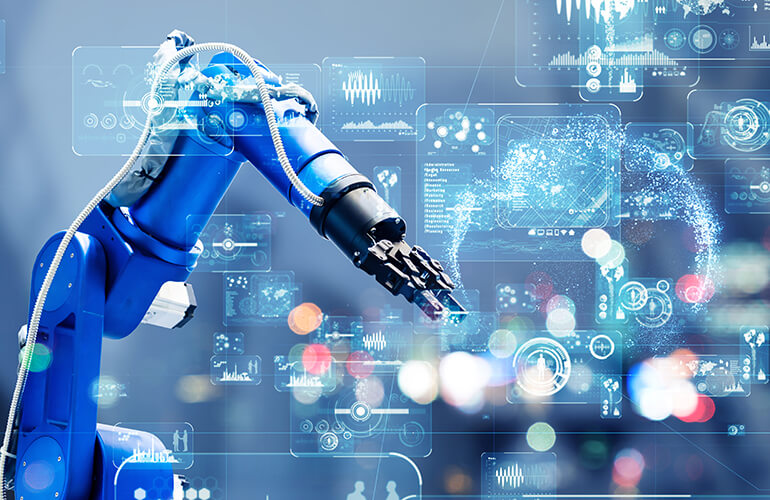
What Does the Near Future of Robotics Hold?
26 Feb, 20245 mins
Henry Ford once famously said, “if I had asked people what they wanted, they would have said faster horses”. This line is often discussed in the context of the merits of customer feedback. Look a little more closely, though, and there’s a statement in there about how completely transformative the advent of the motor car was.
Ford and the other early pioneers of automotive technology arrived near the end of the industrial revolution. That period saw a shift from a world in which economic productivity was almost entirely dependent on the physical labour of humans and their domesticated animals, to one in which machines did the bulk of the heavy lifting.
This shift is still ongoing, but it is rapidly approaching an inflection point. Machines have for decades built other machines, but advanced robots are now capable of performing even more of the laborious, dangerous work that, when all is said and done, humans would rather not do.
The era of the robot butler is nigh, and the next time a war breaks out, expect to see robots all over the battlefield.
Driving Industry
Ford was an early adopter of scientific management theory, an approach to manufacturing created by Frederick Winslow Taylor that involved careful analysis of the human labour at every stage of the production line. Following in Ford’s footsteps carmakers have long been at the forefront of minimising the quantity and maximising the efficiency of human labour in manufacturing, by applying robotic technology to production lines. According to the International Federation of Robotics, the automobile industry now “employs” over one million robots globally; more than any other industry.
These robots take the form of selective compliance articulated robot arm (SCARA) robots — stationary, articulated arms that perform a specific function on a production line — to collaborative robots, or ‘cobots’, that assist humans with a task or that can be taught by a human how to perform one continuously. For example, the Yu 5 Industrial, from Munich-based Agile Robots, is a multisensory, intuitive cobot that can quickly and easily be taught new tasks by a human operator with no specialised knowledge.
There is also an increasing number of autonomous mobile robots (AMRs) that use artificial intelligence (AI) such as computer vision to move independently around factories.
However, robotic technology has spread far beyond the auto sector in the world of manufacturing. Biotech giant GSK announced in January that advanced robotics, machine learning and AI technologies are being deployed at its plants in order to speed the production and delivery of vital medicines and vaccines.
Boston Dynamics caught the attention of the robotics world in December 2020 when it released a video of its Atlas robot dancing to the song Do You Love Me. While Atlas represents one of the most impressive humanoid robots in existence, most of Boston Dynamics’ commercial robots are workers more than dancers.
As well as Stretch — an automated robotic arm that can traverse warehouses and factories to pick up various objects — Boston Dynamics also creates Spot, a quadrupedal robot that walks around industrial floors, gathering data enabling the creation of a digital twin which in turn allows operators to simulate and improve operations.
Delivering Benefits
Robots aren’t just making things for us; they’re bringing them to our front door.
Zipline is a US-based company that develops delivery drones. These started out as medical products in Rwanda, but it now delivers food, retail, agriculture products, and animal health products in the US, Ghana, Nigeria, Cote d'Ivoire, Kenya and Japan as well.
Zipline’s drones are automated, and utilise advanced computer imaging systems to identify the exact spot that packages should be delivered.
And it isn’t just goods that robots transport. Autonomous vehicles — of the type being developed by global giants like Tesla and Waymo — are effectively robots in the shape of cars. Like we say, robots and automobiles go hand in hand; robots are making robots, and those robots are moving humans from door to door.
Built to Serve
But what about the home inside that door? Does robotic involvement in our lives end once we reach our destination?
The answer is already a firm no, as the existence of automated household appliances (such as the Roomba hoover from iRobot) demonstrate.
Domestic robots are on the verge of their own revolution, though. Tesla is once again at the forefront; its Optimus robot represents Elon Musk’s vision of a near future in which affordable humanoid robots will perform household chores.
Optimus Gen 2 was unveiled in December. Based on a promotional video released on X, it appears to feature hands with the dexterity to grasp an object like an egg strongly enough to hold it, but lightly enough not to break it. This has long been one of the most problematic challenges for robot makers.
Tesla plans to use Optimus robots in its own production processes, with a view to selling them once its usefulness has been proven.
Another company working on humanoid robots is 1X. Its humanoid robots (androids) are modelled on human musculature, giving them a durable and human-like range of movements. The EVE model moves using a wheeled chassis, and is already deployed in commercial settings (such as manufacturing, or as part of security teams) across the world.
However, 1X’s NEO, currently in development, promises far more. NEO will be fully bipedal, and 1X expects that the android will eventually offer “valuable home assistance” by “performing chores like cleaning or organising”.
The question that Tesla and other domestic robot manufacturers are contending with is price. Robots that can perform such tasks are now becoming a reality, but the costs of producing them are, at present, prohibitively high for the vast majority of consumers. However, in the same way that buying a car or a dishwasher was a major economic decision fifty years ago, household robots could fall in price over the coming years and decades, to the point at which they become commonplace.
New Battlegrounds
Having a robot butler fold your shirts might sound luxurious and trivial in equal measure. But robots are increasingly taking a much graver burden off human shoulders; they are starting to fight our wars for us.
Since Russia’s invasion in 2022, the Ukrainian army has made extensive use of drones to surveille and bombard the invading forces. Britain, the Netherlands, and other European allies recently agreed to deliver more advanced drones to Ukraine, but even small consumer drones are now frequently attached to artillery units in order to fly directly above targets and help calibrate artillery fire.
Robotic involvement in warfare may soon be even greater. The US, China, the United Kingdom, India, Iran, Israel, South Korea, Russia and Turkey are all, according to Al Jazeera, investing heavily in ‘lethal autonomous weapons systems’ (LAWS); robots capable of identifying and killing human targets themselves. The first recorded instance of these is believed to be an attack by Turkish drones on Libyan soldiers during 2020.
These developments are of course highly controversial. While it’s obviously preferable to have robots taking bullets in place of human soldiers, the idea of programming machines to conduct violence provokes fears that have been fuelled by decades of sci-fi disaster films. Al Jazeera reports that a growing coalition of nations is pushing to regulate the use of LAWS, and that their use might become morally and legally taboo (similarly to chemical weapons).
Reasons for Optimism
As with any disruptive technological trend, the proliferation of robotic technology has its detractors as well as its proponents. This holds outside the battlefield, too.
For every task a robot learns how to do, a human loses employment; history teaches us that, over time, the benefits of this displacement outweigh the short term individual pain, but businesses and policymakers will need to ensure that the benefits of robotic technology are shared throughout societies and economies, rather than concentrating wealth into a small number of hands.
Here’s the thing, though. Robots have been playing a bigger and bigger role in our lives for decades, but employment rates in the economies that use them the most are at record highs. And while the prospect of remote drone strikes pose obvious headaches for military strategists, nothing close to a rogue, civilian-killing robot has come even close to creation.
So, here at Oho Group, we’re optimistic about the future of a world where robots do the hard, dangerous work, and the rest of us get on with our lives.
Contact our team of innovation-focused consultants if you are working, or hiring, at the forefront of the robot revolution.

